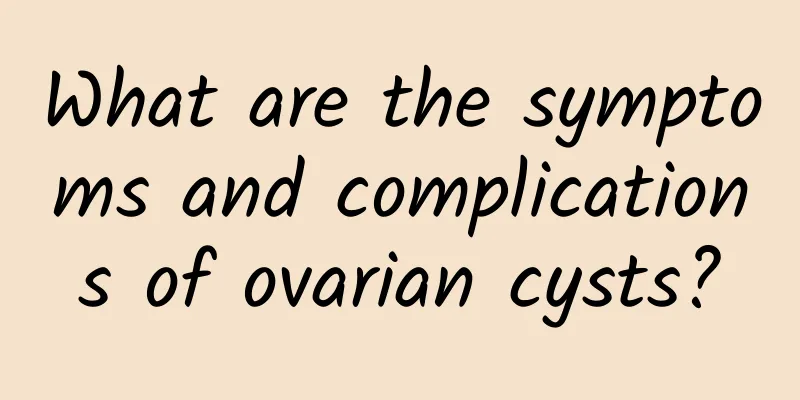What are the symptoms and complications of ovarian cysts?

|
What are the symptoms of ovarian cysts? What are the complications? Ovarian cysts have no obvious clinical manifestations in the early stages. Experts say that the symptoms of ovarian cysts are: 1. Abdominal pain: Ovarian tumor torsion, rupture or infection, detachment of uterine fibroids or degeneration of fibroids can cause severe lower abdominal pain. 2. Changes in diet and urine: The early symptoms of ovarian cancer may be just abdominal distension and digestive tract symptoms. Tumor compression or invasion of the bladder and rectum can cause frequent urination, difficulty urinating, dry stools, etc. 3. Menstrual changes: When tumors grow in the uterus, such as uterine fibroids, endometrial cancer, uterine sarcoma, and choriocarcinoma, menstrual abnormalities may occur, including menorrhagia, irregular periods, prolonged menstruation, spotting, etc. 4. Abnormal vaginal discharge: When a female reproductive tract cyst ruptures and becomes necrotic, watery, bloody, or rice-like vaginal discharge may occur. If combined with infection, it may have a peculiar smell. In fact, untimely treatment of ovarian cysts can lead to the following complications: 1. Cyst rupture: About 3% of ovarian tumors will rupture, and the ovarian tumor pedicles will twist, which is traumatic and spontaneous. After the cyst ruptures, it often causes severe abdominal pain, nausea and vomiting, and sometimes causes internal bleeding, peritonitis and shock. 2. Infection: Less common, mainly caused by tumor torsion or rupture, but also from the spread of appendix abscess and other adjacent organ infection. Antibiotics should be used for treatment, followed by surgical removal of the tumor. If the infection cannot be controlled in the short term, surgery should be performed immediately. 3. Pedicle torsion: It is one of the acute abdominal diseases in gynecology. About 10% of ovarian tumors are complicated by pedicle torsion. 4. Malignant changes: Malignant changes of benign ovarian cysts often occur in older women, especially after menopause. The cysts increase rapidly in a short period of time. Patients feel abdominal distension and loss of appetite. The cysts increase significantly in size, become fixed, and contain a lot of ascites. |
<<: Is chronic cervicitis serious?
>>: What are the symptoms of cervical precancerous lesions?
Recommend
Dietary considerations for chronic pelvic inflammatory disease
If you want to cure chronic pelvic inflammatory d...
Can I get pregnant with pelvic inflammatory mass?
Pelvic inflammatory mass may interfere with pregn...
Why is there still blood half a month after the abortion? You should get treatment in time
If you still have vaginal bleeding half a month a...
Common symptoms of irregular menstruation
Irregular menstruation is a symptom of women'...
Common and easily identifiable manifestations of vaginitis
Although vaginitis is a common gynecological dise...
Is the sodium content in bento so high? Nutritionist: 4 tips for people who eat out to get rid of annoying edema
A few days ago, the Consumers' Foundation ran...
How to prevent Bartholinitis
Overview of Bartholinitis: Bartholin glands, also...
Is vulvar itching hereditary?
Vulvar pruritus is a common gynecological disease...
Li Ying loves to eat grapes to lose weight. Anthocyanin promotes metabolism
In addition to their sweet and sour taste, grapes...
How much does it cost to treat pelvic peritonitis?
Experts say that there are many causes of pelvic ...
What is congenital absence of vagina?
What kind of disease is congenital absence of vag...
See how serious the causes of recurrence of Trichomonas vaginitis are
Trichomonas vaginitis is an inflammation caused b...
What are the effects of adnexitis?
What are the effects of adnexitis? Adnexitis refe...
What are the main symptoms of cervicitis?
Among the many diseases of the cervix, cervicitis...
Diet care for vulvar leukoplakia
Vulvar leukoplakia is the most common gynecologic...









